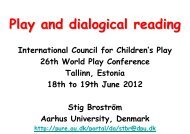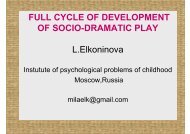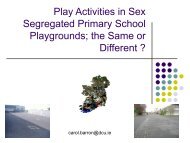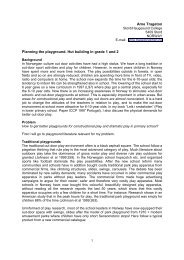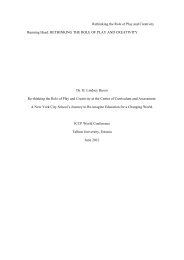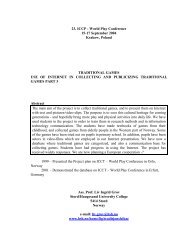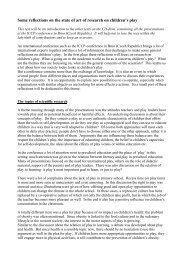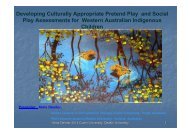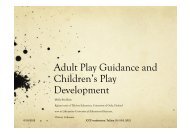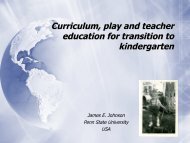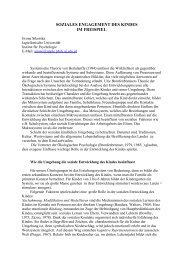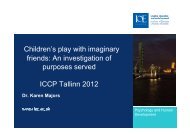Professor Aili Helenius and Dr Riitta Korhonen
Professor Aili Helenius and Dr Riitta Korhonen
Professor Aili Helenius and Dr Riitta Korhonen
Create successful ePaper yourself
Turn your PDF publications into a flip-book with our unique Google optimized e-Paper software.
Developmental Trends of Children’s<br />
Play Cultures in Finl<strong>and</strong> from 1950<br />
to 2012<br />
preliminary impressions<br />
<strong>Aili</strong> <strong>Helenius</strong> & <strong>Riitta</strong> <strong>Korhonen</strong>, University of Turku, Finl<strong>and</strong><br />
Play Conference in Tallinn 17.-20.6.2012
Culture<br />
Culture is the totality of mental<br />
<strong>and</strong> material affordances of<br />
mankind or locality, something<br />
that forms the context of our<br />
living. Tradition is part of the<br />
culture, typically anonymous <strong>and</strong><br />
memorized. (Virtanen 1991)
Forms of tradition<br />
Tradition can be understood as<br />
past, present <strong>and</strong> future.<br />
The past consists of<br />
(1) times which are almost<br />
unknown<br />
(2) past times which exist<br />
passively in people’s minds<br />
(3) aspects of the past which are<br />
still a part of people’s lives.<br />
(Suojanen 1999)
Children's folklore 1/2<br />
Children's folklore is one of the most<br />
ancient of continuous traditions, <strong>and</strong><br />
may be divided into two main sections -<br />
the folklore of children, <strong>and</strong> folklore for<br />
children.<br />
The folklore of children -children's<br />
own lore – includes playing, the playground<br />
rhymes, games, chants, counting-out rituals,<br />
taunts <strong>and</strong> insults which are passed on from<br />
one 'generation' of primary-school children to<br />
another, usually in the school playground.
Children’s folklore 2/2<br />
Children's own lore It includes<br />
nursery rhymes, bouncing or 'd<strong>and</strong>ling'<br />
games, traditional fairytale stories <strong>and</strong><br />
family sayings.<br />
It is transmitted from child to child,<br />
whereas folklore for children is passed<br />
on from adults to children, who in turn<br />
pass it on to their children.
Questions<br />
• What is happening to the culture<br />
for children?<br />
• What is happening to the<br />
children`s culture <strong>and</strong> play?<br />
- especially in institutional settings<br />
of early childhood education
Data<br />
1) Observations from contemporary teachers<br />
2) A collection of play episodes, gathered from ( female)<br />
persons, asked to write down just the first episode<br />
entering to mind, while thinking about their play in<br />
their earliest childhood.<br />
Are we able to read something important from these<br />
circa thous<strong>and</strong> peaces of childhood memories as well<br />
as recent observations?<br />
This paper contains just<br />
preliminary observations concerning<br />
will be analysed later in more detail.<br />
the data which<br />
7
Memory<br />
Autobiographical memory is possible not<br />
before the emergence of the cognitive self.<br />
(“childhood amnesia” is typical for the first<br />
years).<br />
Implicit (nondeclarative) memory begins<br />
early, perhaps before birth.<br />
Memory is compressing, reducing,<br />
simplifying,<br />
8
Characteristics of the data<br />
A minority of the experiences are single<br />
object-specific play actions of<br />
the toddlers <strong>and</strong> they differ<br />
qualitatively from the narratives of the<br />
later ages.<br />
The majority of the data concerns role<br />
play of children in the pre–school years or<br />
in the early school years.<br />
Circa one third of the data come from<br />
group-play of older children playing<br />
traditional outdoor rule games.<br />
9
Typical contents of the<br />
narratives<br />
1)With whom?<br />
Whom the informant was playing with in the recalled<br />
episode?<br />
2) Where?<br />
Where did the children play?<br />
3) Equipment ?<br />
What do the participants tell about the equipment ?<br />
10
Narrative – example 1<br />
“My friend from the neighbour house was one<br />
year older than me. Insulator from the electric<br />
pole, <strong>and</strong> the porcelain h<strong>and</strong>le of the milk jug<br />
made an excellent telephone. Cups were made<br />
from the broken dishes. The blooms of lily-ofthe<br />
valley were put in a porcelain container to<br />
make a scent-powder. I had a ragdoll made<br />
from my sister. It was wonderful to shake the<br />
old piece of rag dug <strong>and</strong> sweep the floor in the<br />
site hut, which as if was our home.”<br />
11
Pre-school tearcher’s view –<br />
Excample 2<br />
” Heroes in the series of TV are strongly<br />
present in children’s role plays. The<br />
plays of caring are less than earlier.<br />
More than earlier children need support<br />
<strong>and</strong> active participation from adults.<br />
Are abilities of playing <strong>and</strong> models<br />
from everyday life disappearing? -<br />
everyday life in families, ent routines in<br />
evenings - hectic life with hobby<br />
activities -the missing of everyday life<br />
all together.”
Conclusions 1/2<br />
Role-play – leading activity –<br />
personality development in play<br />
Playing=learning<br />
?<br />
Is play-activity missing in the planning<br />
practice of practitioners?<br />
Is it missing in the curriculum of the<br />
teachers or coming too short?<br />
13
Conclusions 2/2<br />
Children's folklore is one of the<br />
most ancient of continuous<br />
traditions:<br />
1) What happens to the folklore of<br />
children?<br />
2) What happens to the folklore for<br />
children?



